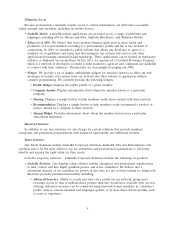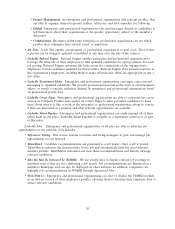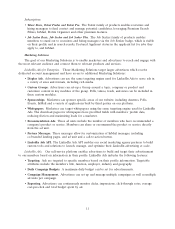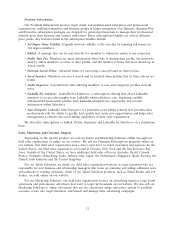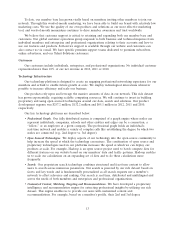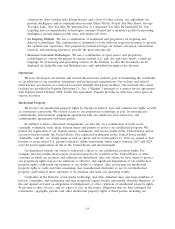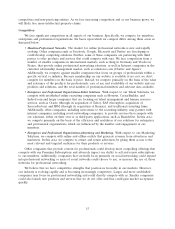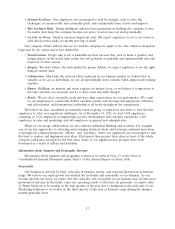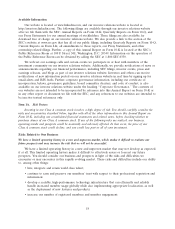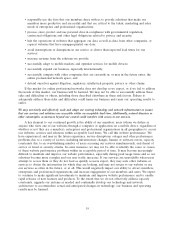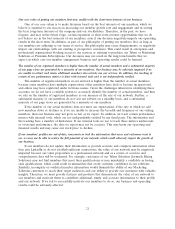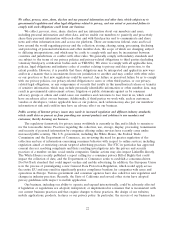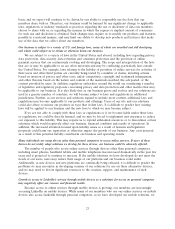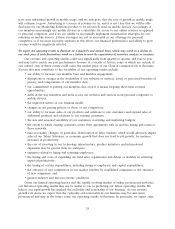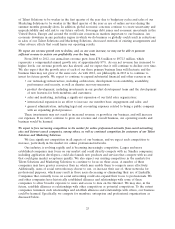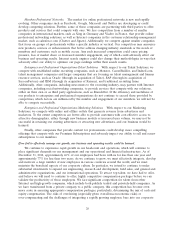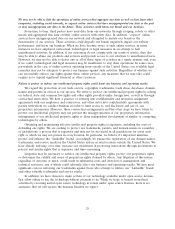LinkedIn 2012 Annual Report Download - page 21
Download and view the complete annual report
Please find page 21 of the 2012 LinkedIn annual report below. You can navigate through the pages in the report by either clicking on the pages listed below, or by using the keyword search tool below to find specific information within the annual report.• responsibly use the data that our members share with us to provide solutions that make our
members more productive and successful and that are critical to the talent, marketing and sales
needs of enterprises and professional organizations;
• process, store, protect and use personal data in compliance with governmental regulation,
contractual obligations and other legal obligations related to privacy and security;
• halt the operations of websites that aggregate our data as well as data from other companies, or
copycat websites that have misappropriated our data;
• avoid interruptions or disruptions in our service or slower than expected load times for our
services;
• increase revenue from the solutions we provide;
• successfully adapt to mobile markets and optimize services for mobile devices;
• successfully expand our business, especially internationally;
• successfully compete with other companies that are currently in, or may in the future enter, the
online professional network space; and
• defend ourselves against litigation, regulatory, intellectual property, privacy or other claims.
If the market for online professional networks does not develop as we expect, or if we fail to address
the needs of this market, our business will be harmed. We may not be able to successfully address these
risks and difficulties or others, including those described elsewhere in these risk factors. Failure to
adequately address these risks and difficulties could harm our business and cause our operating results to
suffer.
We may not timely and effectively scale and adapt our existing technology and network infrastructure to ensure
that our services and solutions are accessible within an acceptable load time. Additionally, natural disasters or
other catastrophic occurrences beyond our control could interfere with access to our services.
A key element to our continued growth is the ability of our members, users (whom we define as
anyone who visits one of our websites through a computer or application on a mobile device, regardless of
whether or not they are a member), enterprises and professional organizations in all geographies to access
our websites, services and solutions within acceptable load times. We call this website performance. We
have experienced, and may in the future experience, service disruptions, outages and other performance
problems due to a variety of factors, including infrastructure changes, human or software errors, capacity
constraints due to an overwhelming number of users accessing our services simultaneously, and denial of
service or fraud or security attacks. In some instances, we may not be able to identify the cause or causes
of these website performance problems within an acceptable period of time. It may become increasingly
difficult to maintain and improve our website performance, especially during peak usage times and as our
solutions become more complex and our user traffic increases. If our services are unavailable when users
attempt to access them or they do not load as quickly as users expect, they may seek other websites or
services to obtain the information for which they are looking, and may not return to our website or use
our services as often in the future, or at all. This would negatively impact our ability to attract members,
enterprises and professional organizations and increase engagement of our members and users. We expect
to continue to make significant investments to maintain and improve website performance and to enable
rapid releases of new features and products. To the extent that we do not effectively address capacity
constraints, upgrade our systems as needed and continually develop our technology and network
architecture to accommodate actual and anticipated changes in technology, our business and operating
results may be harmed.
19


